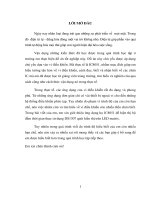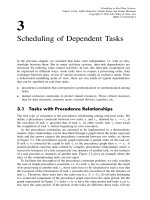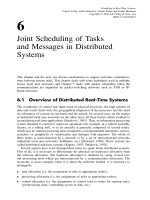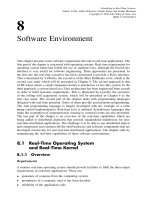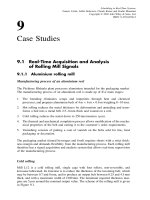Lịch khai giảng trong các hệ thống thời gian thực P1
Bạn đang xem bản rút gọn của tài liệu. Xem và tải ngay bản đầy đủ của tài liệu tại đây (259.27 KB, 21 trang )
1
Basic Concepts
1.1 Real-Time Applications
1.1.1 Real-time applications issues
In real-time applications, the timing requirements are the main constraints and their
mastering is the predominant factor for assessing the quality of service. Timing con-
straints span many application areas, such as industrial plant automation, embedded
systems, vehicle control, nuclear plant monitoring, scientific experiment guidance,
robotics, multimedia audio and video stream conditioning, surgical operation moni-
toring, and stock exchange orders follow-up.
Applications trigger periodic or random events and require that the associated com-
puter system reacts before a given delay or a fixed time. The timing latitude to react
is limited since transient data must be caught, actions have a constraint on both start
and finish times, and responses or commands must be sent on time.
The time scale may vary largely, its magnitude being a microsecond in a radar, a
second in a human–machine interface, a minute in an assembly line, or an hour in a
chemical reaction.
The source of timing constraints leads to classifying them as hard or soft. A real-time
system has hard timing constraints when a timing fault (missing a deadline, delivering
a message too late, sampling data irregularly, too large a scatter in data supposed to
be collected simultaneously) may cause some human, economic or ecological disaster.
A real-time system has soft timing constraints when timing faults can be dealt with to
a certain extent.
A real-time computer system is a computer system whose behaviour is fixed by
the dynamics of the application. Therefore, a real-time application consists of two
connected parts: the controlling real-time computer system and the controlled process
(Figure 1.1).
Time mastery is a serious challenge for real-time computer systems, and it is often
misunderstood. The correctness of system reactions depends not only on the logical
results of the computations, but also on the time at which the results are produced.
Correct data which are available too late are useless; this is a timing fault (Burns and
Wellings, 1997; Lelann, 1990; Stankovic, 1988).
A controlling real-time computer system may be built as:
• a cyclic generator, which periodically samples the state of the controlled process,
computes the measured data and sends orders to the actuators (this is also called
synchronous control);
Scheduling in Real-Time Systems.
Francis Cottet, Jo¨elle Delacroix, Claude Kaiser and Zoubir Mammeri
Copyright
2002 John Wiley & Sons, Ltd.
ISBN: 0-470-84766-2
2 1BASICCONCEPTS
Control computer system
• automata
• uniprocessor
• multiprocessor
• local area network
Controlled process
• primary equipment
• complex process
• equipment set
Actions
Observations
Displays
Events
Orders
Measurements
Figure 1.1 Scheme of a real-time application
• a reactive system, which responds instantaneously to the stimuli originating in the
controlled process and thus is triggered by its dynamics;
• a union of both aspects, which schedules periodic and aperiodic tasks; this results
in an asynchronous system.
1.1.2 Physical and logical architecture,
operating systems
Software design of a real-time application
Several steps are usually identified to analyse and implement real-time applications.
Some of them are:
• requirements analysis and functional and timing specifications, which result in a
functional view (the question to answer is: what should the system do?).
• preliminary design, which performs an operational analysis (the question is: how
to do it?) and leads to the choice of logical components of a logical architecture.
• specific hardware and software development. They are often developed concurrently
with similar design processes. The hardware analysis (the question is: with which
hardware units?) leads to a physical architecture, to the choice of commercial
1.1 REAL-TIME APPLICATIONS 3
off-the-shelf components and to the detailed design and development of special
hardware. The conceptual analysis (the question is: with which software modules?)
leads to a software architecture, to the choice of standard software components and
to the implementation of customized ones. These acquisition and realization steps
end with unit testing.
• integration testing, which involves combining all the software and hardware com-
ponents, standard ones as well as specific ones, and performing global testing.
• user validation, which is carried out by measurements, sometimes combined with
formal methods, and which is done prior to acceptance of the system.
These steps are summarized in Figure 1.2, which gives an overview of the main
design and implementation steps of real-time applications. Once the logical and hard-
ware architecture is defined, an allocation policy assigns the software modules to the
hardware units. In distributed fault-tolerant real-time systems, the allocation may be
undertaken dynamically and tasks may migrate. The operational analysis must define
the basic logical units to map the requirements and to express concurrency in the sys-
tem, which is our concern. The operational behaviour of the application is produced
by their concurrent execution.
The major computing units are often classified as:
• passive objects such as physical resources (devices, sensors, actuators) or logical
resources (memory buffers, files, basic software modules);
• communication objects such as messages or shared variables, ports, channels, net-
work connections;
• synchronization objects such as events, semaphores, conditions, monitors (as in
Modula), rendezvous and protected objects (as in Ada);
Software
Hardware
Requirements
analysis
Preliminary
design
Detailed
design
Detailed
design
Validation
Integration
Coding
Test Test
Realization
Figure 1.2 Joint hardware and software development
4 1BASICCONCEPTS
• active objects such as processes, threads, tasks;
• structuring, grouping and combining objects such as modules, packages (as in Ada),
actors (as in Chorus), processes (as in Unix, Mach).
In real-time systems, the word task is most often used as the unit for representing con-
current activities of the logical architecture. The physical parallelism in the hardware
architecture and the logical parallelism in the application requirements are usually the
base for splitting an application into concurrent tasks. Thus a task may be assigned to
each processor and to each input–output device (disk reader, printer, keyboard, display,
actuator, sensor), but also to each distinct functional activity (computing, acquisition,
presentation, client, server, object manager) or to each distinct behavioural activity
(periodic, aperiodic, reactive, cyclic, according to deadline or importance).
Physical architecture
Real-time systems hardware architectures are characterized by the importance of
input–output streams (for example the VME bus in Figure 1.3). An example of physical
architecture, the robot engine of the Pathfinder mission, will be presented in Chapter 9.
The configuration of the embedded architecture is given in Figure 9.10. Figure 1.3
shows an example of a symmetric multiprocessor architecture with shared memory
(Banino et al., 1993).
Distributed architectures over networks are being developed more and more. Chap-
ter 6 is devoted to message scheduling, which is a major element in the mastery of
timing constraints. We shall use the term interconnected sites. Figure 1.4 summarizes
an architecture using local networks to interconnect several sites.
Processor VME interrupts
Legend:
Processors: CPU1, ..., CPU4
Shared memories: MEM1, ..., MEM6
Controllers: VMEBD, I/OBD
Interrupt dispatcher: INTER
Memory bus
VME bus
••• •••
CPU1
CPU4
MEM1
MEM6
INTER
VMEBD
I/OBD
VMEBD
Figure 1.3 Dune 3000 symmetric multiprocessor architecture with shared memory
1.1 REAL-TIME APPLICATIONS 5
Industrial local area network
Office network
Fieldbus
Machine tool
Robot
Conveyer
Robot
controller
Machine tool
controller
Conveyer
controller
Industrial local area network
Cell controller Cell controller
Computer-assisted
manufacturing
Industrial database
server
Engineering and
design department
After-sales service
Customer management
Maintenance
Camera
Figure 1.4 Example of a distributed architecture of real-time application
Logical architecture and real-time computing systems
Operating systems In order to locate real-time systems, let us briefly recall that
computing systems may be classified, as shown by Figure 1.5, into transformational,
interactive and reactive systems, which include asynchronous real-time systems.
The transformational aspect refers to systems where the results are computed with
data available right from the program start and usable when required at any moment.
The relational aspect between programming entities makes reference to systems where
the environment-produced data are expected by programs already started; the results
6 1BASICCONCEPTS
Interactive systems
(e.g. office automation, CAD)
Algorithms
Synchronization
and communication
Timing
properties
Transformational
aspect
Relational aspect
between software
entities
Timing
aspect
Behavioural
aspect
Transformational systems
(e.g. mathematical computations)
Input data without
timing constraints
Reactive systems
3
1 2
3
2
1
Environment-produced
data with timing constraints
Environment-produced
data without timing constraints
Figure 1.5 Classes of computing systems
of these programs are input to other programs. The timing aspect refers to systems
where the results must be given at times fixed by the controlled process dynamics.
A system is centralized when information representing decisions, resource sharing,
algorithms and data consistency is present in a shared memory and is directly accessible
by all tasks of the system. This definition is independent of the hardware architecture.
It refers to a uniprocessor or a shared memory multiprocessor architecture as well
as to a distributed architecture where all decisions are only taken by one site. A
system is distributed when the decisions are the result of a consensus among sites
exchanging messages.
Distributed programming has to cope with uncertainty resulting from the lack of a
common memory and common clock, from the variations of message transfer delays
from one site to another as well as from one message to another, and from the existence
of an important fault rate. Thus, identical information can never be captured simul-
taneously at all sites. As the time is one of these pieces of information, the sites are
not able to read a common clock simultaneously and define instantaneously whether
or not ‘they have the same time’.
1.1 REAL-TIME APPLICATIONS 7
Computing systems are structured in layers. They all contain an operating system
kernelas shown in Figure 1.6. This kernel includes mechanisms for the basic man-
agement of the processor, the virtual memory, interrupt handling and communication.
More elaborate management policies for these resources and for other resources appear
in the higher layers.
Conventional operating systems provide resource allocation and task scheduling,
applying global policies in order to optimize the use of resources or to favour the
response time of some tasks such as interactive tasks. All tasks are considered as
aperiodic: neither their arrival times nor their execution times are known and they
have no deadline.
In conventional operating systems the shared resources dynamically allocated to
tasks are the main memory and the processor. Program behaviour investigations have
indicated that the main memory is the sensitive resource (the most sensitive are demand
paging systems with swapping between main memory and disk). Thus memory is
allocated first according to allocation algorithms, which are often complicated, and the
processor is allocated last. This simplifies processor scheduling since it concerns only
the small subset of tasks already granted enough memory (Bawn, 1997; Silberscharz
and Galvin, 1998; Tanenbaum, 1994; Tanenbaum and Woodhull, 1997). Conventional
operating systems tend to optimize resource utilization, principally the main memory,
and they do not give priority to deadline observances. This is a great difference with
real-time operating systems.
Real-time operating systems In real-time systems, resources other than the proces-
sor are often statically allocated to tasks at their creation. In particular, time should
not be wasted in dynamic memory allocation. Real-time files and databases are not
stored on disks but reside in main memory; this avoids the non-deterministic disk track
seeking and data access. Input–output management is important since the connections
with the controlled process are various. Therefore, the main allocation parameter is
processor time and this gives importance to the kernel and leads to it being named
Hardware
Kernel
Operating system
services
Semaphores
Scheduler
Internet
management
Clock
management
Virtual memory
management
Peripheral
drivers
Network
drivers
Task
management
Memory
management
File
management
Objects
management
Middleware
Messaging
service
Libraries
Database
management
Human–machine
interface
Name
server
Applications
···
···
···
Figure 1.6 Structure of a conventional system
8 1BASICCONCEPTS
Real-time kernel
User program
Scheduler
Primitives
Interrupt
handling
Internet
Data
Task i Task j Task k
P R O C E S S
Request Activation
Figure 1.7 Schema of a real-time application
the real-time operating system (Figure 1.7). Nevertheless, conventional operating sys-
tem services are needed by real-time applications that have additional requirements
such as, for example, management of large data sets, storing and implementing pro-
grams on the computer also used for process control or management of local network
interconnection. Thus, some of these conventional operating systems have been reengi-
neered in order to provide a reentrant and interruptible kernel and to lighten the task
structure and communication. This has led to real-time Unix implementations. The
market seems to be showing a trend towards real-time systems proposing a Posix
standard interface (Portable Operating System Interface for Computer Environments;
international standardization for Unix-like systems).
1.2 Basic Concepts for Real-Time Task
Scheduling
1.2.1 Task description
Real-time task model
Real-time tasks are the basic executable entities that are scheduled; they may be peri-
odic or aperiodic, and have soft or hard real-time constraints. A task model has been


